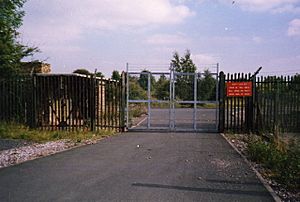ROF Swynnerton facts for kids
ROF Swynnerton was a very important factory in the United Kingdom during World War II. It was a special kind of Royal Ordnance Factory called a "filling factory." This meant its job was to fill bombs and shells with explosive materials. The factory was built near the village of Swynnerton in Staffordshire. It started working in 1940 and kept going until 1958. Today, the area is used by the Defence Training Estate as a military training camp.
Contents
Building a Secret Factory
To build ROF Swynnerton, about 1,200 acres of land were taken over. This land mostly came from the Swynnerton and Cotes estates. Expert engineers, Sir Alexander Gibb & Partners, helped plan and supervise the building work. The main ideas for how the factory would work came from the Royal Arsenal in Woolwich, which was a very old and important factory.
Safety First: A Dangerous Job
Filling factories like Swynnerton were the most dangerous types of munitions factories. This is because they handled highly explosive materials. To keep workers safe, the factory was designed with many special features. It had over 1,700 small buildings. Each building was surrounded by big earth banks. If one building exploded by accident, these banks would help stop the blast from reaching other buildings.
The factory also had five large boiler-houses. These were placed far apart around the site. This way, if one or two were bombed, the factory could still keep working. The roads between the buildings were very smooth and clean. They were called 'cleanways' because they had to be kept spotless. This was to make sure no sparks could be created, which might cause an explosion.
Home for Workers
Building the factory was a huge job, and it was finished in just two years. This would normally take five years! Many people came to work at Swynnerton. So, seven residential hostels were built for them to live in. There were also houses and flats for almost 500 families of specialist staff.
Trains for the Factory Workers
By the middle of 1942, ROF Swynnerton was working at full speed. About 18,500 people worked there! Getting all these workers to and from the factory was a big challenge. The Ministry of Supply asked the London, Midland and Scottish Railway (LMS) to build a new train station.
The factory already had a large railway network for moving goods. But the LMS built a new train line just for passengers. This line was almost 2 miles long and went from the North Staffordshire Railway line to a new station called Cold Meece railway station.
Busy Train Schedules
Cold Meece station was only for passengers. All the factory's goods were moved by train from a different link at Badnall Wharf. During the war, the factory worked 24 hours a day. This meant the trains had to run all the time too! There were 19 trains a day, Monday to Saturday, to help workers get to their shifts. These shifts started at 5:35 AM, 1:35 PM, and 8:35 PM.
Trains went to places like Newchapel and Goldenhill, Silverdale, and Blythe Bridge. There was even a special train for workers who lived at the factory to go into Stoke for fun. On Sundays, there were fewer trains, but they still helped people get around.
After the War
After World War II ended, the factory and the train station kept working for a while. The factory finally closed in May 1958. The last regular train ran in June 1958, and the station officially closed in August 1959. The train tracks were removed by September 1963.
What Happened Next?
After the factory closed, the site was changed to be used for military training. It became known as Swynnerton Training Camp. In 2019, there were ideas to build a 'Garden village' on a small part of the site. This would be near the new HS2 railway development.
Images for kids



